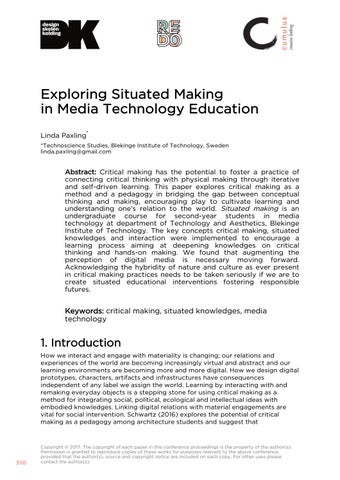Exploring Situated Making in Media Technology Education Linda Paxling* *Technoscience Studies, Blekinge Institute of Technology, Sweden linda.paxling@gmail.com
Abstract: Critical making has the potential to foster a practice of connecting critical thinking with physical making through iterative and self-driven learning. This paper explores critical making as a method and a pedagogy in bridging the gap between conceptual thinking and making, encouraging play to cultivate learning and understanding one’s relation to the world. Situated making is an undergraduate course for second-year students in media technology at department of Technology and Aesthetics, Blekinge Institute of Technology. The key concepts critical making, situated knowledges and interaction were implemented to encourage a learning process aiming at deepening knowledges on critical thinking and hands-on making. We found that augmenting the perception of digital media is necessary moving forward. Acknowledging the hybridity of nature and culture as ever present in critical making practices needs to be taken seriously if we are to create situated educational interventions fostering responsible futures.
Keywords: critical making, situated knowledges, media technology
1. Introduction How we interact and engage with materiality is changing; our relations and experiences of the world are becoming increasingly virtual and abstract and our learning environments are becoming more and more digital. How we design digital prototypes, characters, artifacts and infrastructures have consequences independent of any label we assign the world. Learning by interacting with and remaking everyday objects is a stepping stone for using critical making as a method for integrating social, political, ecological and intellectual ideas with embodied knowledges. Linking digital relations with material engagements are vital for social intervention. Schwartz (2016) explores the potential of critical making as a pedagogy among architecture students and suggest that
510
Copyright Š 2017. The copyright of each paper in this conference proceedings is the property of the author(s). Permission is granted to reproduce copies of these works for purposes relevant to the above conference, provided that the author(s), source and copyright notice are included on each copy. For other uses please contact the author(s).
